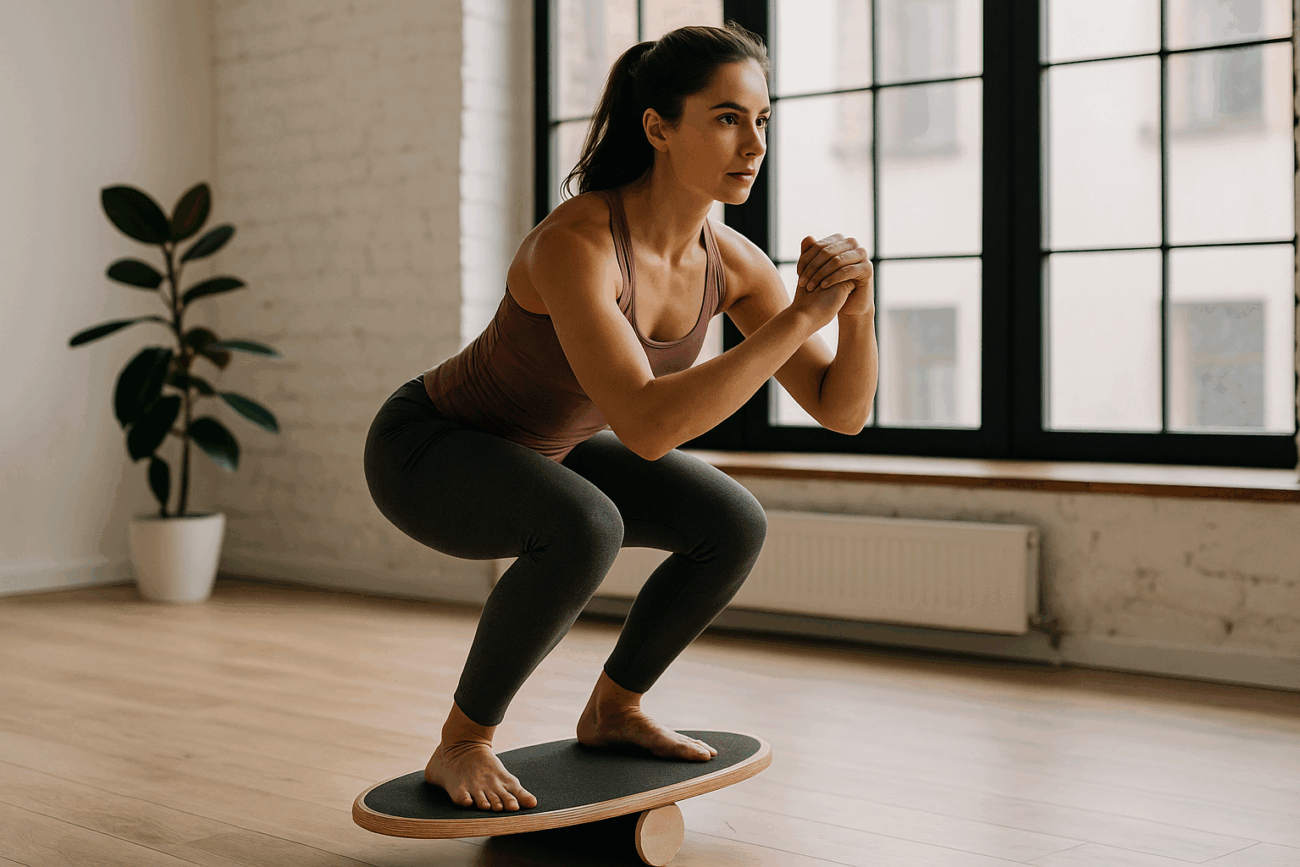Introduction: Balance Training Isn’t Just for Athletes—It’s for Everyone
Ever stumbled on a sidewalk or felt wobbly while climbing stairs? You’re not alone. Many people experience instability, especially after injury, aging, or lack of movement—and balance board exercises are a surprisingly simple solution.
Most think balance boards are only for athletes. But in reality, they’re an incredibly effective tool for rebuilding strength, speeding up rehab, improving posture, and sharpening coordination—for people of all ages and fitness levels.
Whether you’re recovering from an injury, trying to feel steadier in your movements, or just want to add something fun to your fitness routine, balance board exercises can help you get stronger, faster, and more stable—safely and efficiently.
Here’s what you’ll learn:
- What a balance board is and how it works
- How to use a balance board for rehabilitation and recovery
- Easy, low-impact balance board workout for beginners
- A weekly stability board routine you can start today
- Tips to stay safe while improving your coordination and posture
Let’s dive in.
I. What Is a Balance Board and How Does It Work?
A balance board is a flat, moveable surface that shifts as you stand, squat, or move on it. It trains your brain and body to react quickly and stay steady. These exercises are not only fun but essential functional balance exercises for all ages.
Common Types of Balance Boards:
- Wobble board – moves in all directions; ideal for rehab and beginners
- Rocker board – tilts front-to-back or side-to-side; beginner-friendly
- BOSU ball – half-dome great for core stability training and mobility
✅ These tools challenge your muscles, joints, and nervous system—making your whole body more responsive and resilient.
II. Benefits of Balance Board Exercises for Injury Rehab and Recovery
Balance board training is widely used in physical therapy for a reason. It works. Using a balance board for rehabilitation can help restore your mobility and strength.
What They Improve:
- Proprioception – your body’s sense of position, critical in preventing future injuries
- Joint stability – especially for ankle, knee, and hip joints
- Muscle activation – engages stabilizer muscles often missed by machines
- Circulation and healing – reduces stiffness and boosts recovery
📚 Health experts and rehab therapists confirm balance board use helps speed up recovery from injuries like ankle sprains, ACL tears, and joint surgeries.
✅ Especially powerful for balance training for injury recovery and physical therapy.
III. Balance Board Exercises to Improve Core and Stability
These balance board exercises are perfect for seniors, beginners, and anyone easing back into movement:
- Single-Leg Balance Hold – Great for ankle stability and control. Hold 15–30 seconds per leg.
- Plank on Balance Board – A fantastic core stability training move. Hold 20–40 seconds.
- Squats on Wobble Board – Strengthens glutes, hips, and knees.
- Lunge to Step Up – Combines movement and stability.
- Push-Ups with Hands on Board – Targets core and upper body coordination.
- Toe Taps Around Board – Boosts coordination and light cardio for all ages.
- Bird Dog with Hand on Board – Reinforces total-body control and balance.
✅ Try these wobble board exercises near a wall or sturdy surface. Slow and steady always wins.
IV. Everyday Benefits of Functional Balance Board Training
Training on a balance board improves more than your workouts. It prepares your body for real-life tasks:
- Navigating uneven terrain
- Standing safely while carrying bags or groceries
- Preventing falls and slips
- Helping seniors stay independent longer
These functional balance exercises develop confidence, reflexes, and body awareness.
✅ Ideal for balance exercises for seniors, post-injury recovery, or anyone seeking better real-world strength.
V. Beginner-Friendly Weekly Stability Board Routine
You don’t need hours at the gym. A consistent stability board routine for just 5–15 minutes a day can create real change:
| Day | Focus | Example Moves |
|---|---|---|
| Mon | Core Strength | Plank, bird dog |
| Tue | Lower Body | Squats, lunges, toe taps |
| Wed | Recovery | Stretch or light walk |
| Thu | Rehab Focus | Single-leg hold, ankle strengthening exercises |
| Fri | Total Body Balance | Push-ups, step overs |
| Sat | Play-Based Drills | BOSU ball balance games |
| Sun | Light Recovery | Gentle yoga, foam rolling |
✅ Progress by holding longer, using one leg, or moving more slowly.
VI. Safety Tips for Balance Board Beginners
Follow these best practices to stay safe and build strength:
- Practice near a wall or counter for support
- Train barefoot or with grip socks
- Start with short holds (10–30 seconds)
- Keep movements slow and controlled
- If in rehab, consult your PT before starting
✅ These tips make balance board workout for beginners accessible and safe.
Conclusion: Small Shifts, Big Results
Balance board exercises are more than a trend—they’re a gateway to better health, mobility, and confidence.
Whether you’re in recovery, trying to improve balance and core strength, or simply want to move more safely, this tool offers big benefits in a small footprint.
You don’t need a gym. You just need a board, a few minutes, and a steady start.
Try one balance move today—and take the first step toward a stronger, steadier life.
Read more about: Bear Plank Is One of the Best Core Exercises — Here’s Why
Top Balance Exercises to Improve Strength
12 Proven Health Benefits of Good Posture
Harvard Health – Balance Training Benefits
ACE Fitness – Stability and Core Activation
Mayo Clinic – Physical Therapy for Recovery

